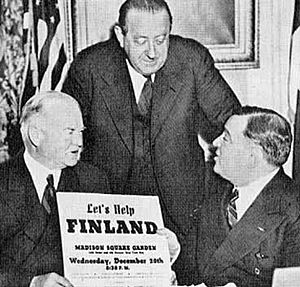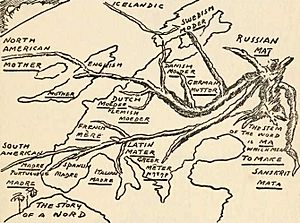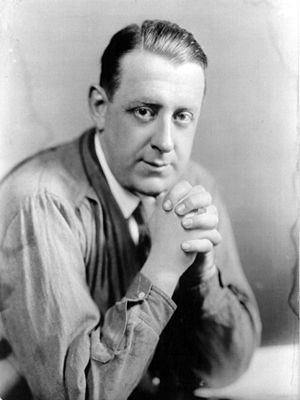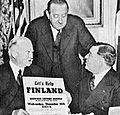Hendrik Willem van Loon facts for kids
Hendrik Willem van Loon (born January 14, 1882 – died March 11, 1944) was a famous historian and writer of books for children. He was born in Rotterdam, a city in the Netherlands. In 1902, he moved to the United States to live and study.
Contents
Early Life and Studies

Hendrik Willem van Loon was born in Rotterdam, Netherlands. His parents were Hendrik Willem van Loon and Elisabeth Johanna Hankin. In 1902, he traveled to the United States to attend Cornell University. He finished his studies and graduated from Cornell in 1905.
In 1906, he married Eliza Ingersoll Bowditch. Her father was a teacher at Harvard. Hendrik and Eliza had two sons, Henry and Gerard. After their wedding, they moved to Munich, Germany. There, Hendrik studied at the University of Munich.
In 1911, he earned his Ph.D. To get this degree, he wrote a long paper called The Fall of the Dutch Republic. He later published this paper as a book in 1913.
Working as a Journalist
During the Russian Revolution of 1905 and at the start of World War I, Hendrik worked for the Associated Press. This was a news organization. He traveled to places where battles were happening. He wrote stories about what the fighting was like.
From 1915 to 1917, he taught at Cornell University. In 1919, he became a citizen of the United States. He later married Eliza Helen Criswell in 1920. He also married Frances Goodrich Ames, a writer, in 1927. He later separated from Frances Ames and reunited with Eliza Criswell. When he passed away in 1944, he left his belongings to Eliza Criswell.
Writing Books for Young Readers
Hendrik Willem van Loon wrote many books. His most famous book is The Story of Mankind. He not only wrote the words but also drew many pictures and maps for it. This book tells the history of the world in a way that children can understand.
The Story of Mankind won the very first Newbery Medal in 1922. This award is given to the best children's book each year. People have continued to read The Story of Mankind for many years. Hendrik's son, Gerard, added new chapters as more history happened. Later, other writers also added to the book. Today, the book has about 500 pages. Hendrik also wrote many other books for children and young adults.
Standing Up Against Injustice
Hendrik Willem van Loon visited Germany many times in the 1920s. But in 1933, when the Nazis took control of Germany, they told him he could not visit anymore.
In 1938, Hendrik wrote a book called Our Battle: Being One Man's Answer to "My Battle" by Adolf Hitler. This book explained why Hendrik disagreed with Adolf Hitler's book Mein Kampf. (Mein Kampf means "My Battle" in the German language.)
Franklin Delano Roosevelt, who was the President of the United States at that time, really liked Hendrik's book. In 1940, Hendrik helped Roosevelt in his campaign to become president again.
Books Written by Van Loon

Here is a list of books that Hendrik Willem van Loon wrote. The dates show when each book was first printed.
- The Fall of the Dutch Republic, 1913
- The Rise of the Dutch Kingdom, 1915
- The Golden Book of the Dutch Navigators, 1916
- A Short History of Discovery: From the Earliest Times to the Founding of Colonies in the American Continent, 1917
- Ancient man; the Beginning of Civilizations, 1920
- The Story of Mankind, 1921
- The Story of the Bible, 1923
- Witches and Witch-Finders, 1923
- The Story of Wilbur the Hat, 1925
- Tolerance, 1925
- The Liberation of Mankind: the story of man's struggle for the right to think, 1926
- America: The Story of America from the very beginning up to the present, 1927
- Adriaen Block, 1928
- Multiplex man, or the Story of Survival through Invention, 1928
- Life and Times of Peter Stuyvesant, 1928
- Man the Miracle Maker, 1928
- R. v. R.: the Life and Times of Rembrandt van Rijn, 1930
- If the Dutch Had Kept Nieuw Amsterdam, in If, Or History Rewritten, edited by J. C. Squire, 1931
- Van Loon's Geography: The Story of the World We Live In, 1932
- "Gold" 1933
- An Elephant Up a Tree, 1933
- An Indiscreet Itinerary or How the Unconventional Traveler Should See Holland by one who was actually born there and whose name is Hendrik Willem Van Loon, 1933
- The Home of Mankind: the story of the world we live in, 1933
- The story of inventions: Man, the Miracle Maker, 1934
- Ships: and How They Sailed the Seven Seas (5000 B.C.-A.D.1935), 1935
- Around the World With the Alphabet, 1935
- Air-Storming: A Collection of 40 Radio Talks, 1935
- Love me not, 1935
- A World Divided is a World Lost, 1935
- The Songs We Sing (with Grace Castagnetta), 1936
- The Arts (with musical illustrations by Grace Castagnetta), 1937
- Christmas Carols (with Grace Castagnetta), 1937
- Observations on the mystery of print and the work of Johann Gutenberg, 1937
- Our Battle: Being One Man's Answer to "My Battle" by Adolf Hitler, 1938
- How to Look at Pictures: a Short History of Painting, 1938
- Folk Songs of Many Lands (with Grace Castagnetta), 1938
- The Last of the Troubadours: The Life and Music of Carl Michael Bellman 1740-1795 (with Grace Castagnetta), 1939
- The Songs America Sings (with Grace Castagnetta), 1939
- My School Books, 1939
- Invasion, being the personal recollections of what happened to our own family and to some of our friends during the first forty-eight hours of that terrible incident in our history which is now known as the great invasion and how we escaped with our lives, 1940
- The Story of the Pacific, 1940
- The Life and Times of Johann Sebastian Bach, 1940
- Good Tidings (with Christmas songs by Grace Castegnetta), 1941
- The Praise of Folly by Desiderius Erasmus of Rotterdam, with a short life of the Author by Hendrik Willem van Loon of Rotterdam who also illustrated the Book, 1942
- Van Loon's Lives: Being a true and faithful account of a number of highly interesting meetings with certain historical personages, from Confucius and Plato to Voltaire and Thomas Jefferson, about whom we had always felt a great deal of curiosity and who came to us as dinner guests in a bygone year, 1942
- Christmas Songs, 1942
- The Message of the Bells (with music by Grace Castagnetta), 1942
- Fighters for Freedom: the Life and Times of Thomas Jefferson and Simon Bolivar, 1943
- The Life and Times of Scipio Fulhaber, Chef de Cuisine, 1943
- Adventures and Escapes of Gustavus Vasa, and how they carried him from his rather obscure origin to the throne of Sweden, 1945
- Report to Saint Peter, upon the kind of world in which Hendrik Willem van Loon spent the first years of his life - an unfinished book published after his death, 1947
Images for kids
-
On December 20, 1939, a meeting to support Finland was held in Madison Square Garden. Finland was fighting in the Winter War at the time. In this picture, from the left, are former president Herbert Hoover, Dr. van Loon, and the mayor of New York, Fiorello La Guardia.
-
This picture from The Story of Mankind shows how Hendrik thought the word "mother" developed in different languages.






